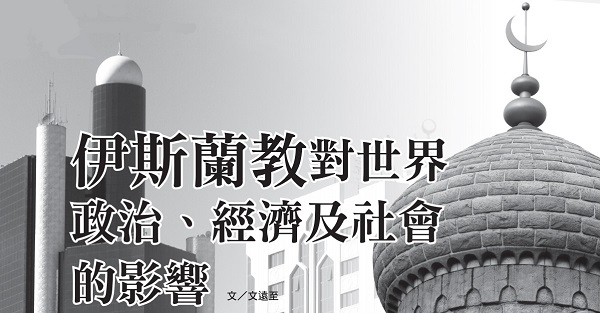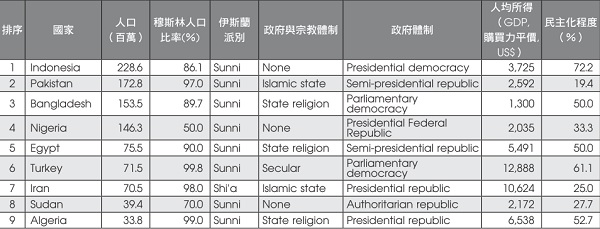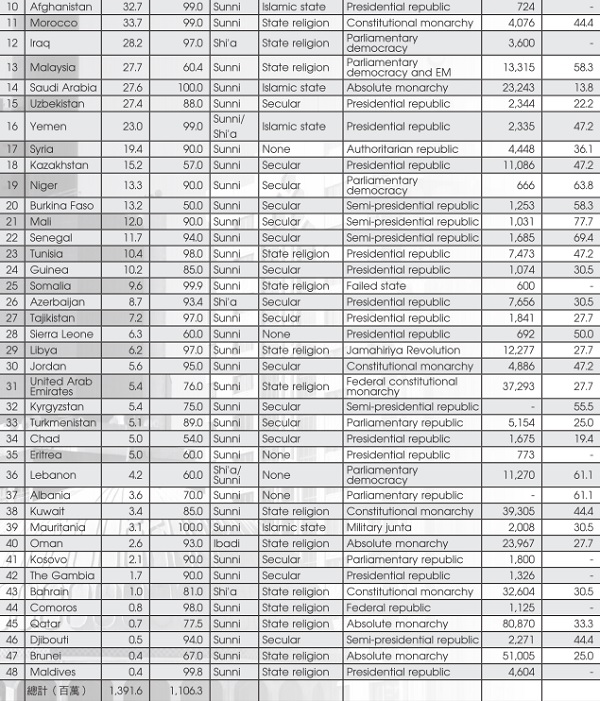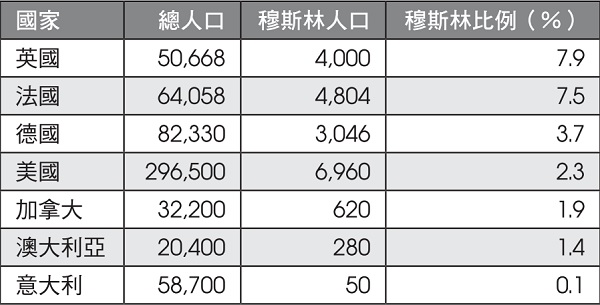The influence of Islam on world politics, economy and society

Preface
在美國大都會區,周圍可能都會遇見穆斯林,或有伊斯蘭教背景的人,可能是鄰居、同事,或來幫助你整修房子的人。1 他們都和睦可親、樂於助人。有些恪守信仰的,還每天定時朝向麥加禱告五次,令人佩服他們的虔誠精神。
In 2001, extremist Muslim terrorists destroyed the Twin World Trade Center in New York and attacked the Pentagon in Washington, DC, killing nearly 3,000 innocent people and triggering the US invasion of Afghanistan and subsequent war in Iraq. Only then did ordinary people in Europe and the United States realize that the power of Islam has affected the communities where they live.
美國是移民的大熔爐,有充分的宗教信仰與言論自由,一般人(包括華人基督徒)對伊斯蘭教或基督教以外的宗教信仰認識其實非常膚淺,於其對世界局勢的影響也缺乏警覺。根據2009年4月《華盛頓郵報》(Washington Post)及美國廣播公司(ABC News)聯合民意調查結果,仍然有超過半數(55%)受訪者對伊斯蘭教的教訓及信仰缺乏了解。2 其中約48%受訪者對伊斯蘭教持負面看法,是2001年以來最高比例;有58%認為伊斯蘭教是和平的宗教;如果有認識穆斯林的,也會認為伊斯蘭教是和平的。
This article wants to explore the possible future development of Islam from the perspective of Islam's impact on world politics, economy and society, and explore how Christians should respond to such changes.
伊斯蘭教擴張簡史3
主後610年(中國隋煬帝時代),伊斯蘭教先知穆罕默德40歲時,於今沙烏地阿拉伯地區宣稱天使向他顯現,讓他複誦阿拉(上帝,阿拉伯語)的啟示(之後成為古蘭經)開始建立伊斯蘭教,以政教合一的方式對外擴張。4 1453年(明代宗時代),以土耳其為首的伊斯蘭教鄂圖曼帝國克服基督教拜占庭帝國,其勢力最高峰時,統治版圖跨越今東歐、中東及北非地區,與當時的神聖羅馬帝國相抗衡。穆斯林勢力因而主宰所統治地區達五世紀之久,直到1918年第一次世界大戰之後鄂圖曼帝國才正式結束。5
At this time, the Islamic world outside the Ottoman Empire had been integrated into non-Islamic European forces. Almost the entire Ottoman Empire was divided into multiple European protectorates and spheres of influence. During the 20th century, most of these European-dominated regions became independent, and new issues such as oil wealth and the question of Israel began to come to the fore.
At the same time, many Muslims immigrated to the Caribbean from India and Indonesia as contract servants, forming the region with the largest Muslim population in the Americas. In addition, urbanization and increased trade in Africa allowed Muslims to settle in new areas and spread Islam in these areas. As a result, the number of Muslims in sub-Saharan Africa doubled between 1869 and 1914. 66
Table 1: Basic statistics of major Islamic countries (2007)


(Data source: Column AH, compiled from http://en.wikipedia.org/wiki/List_of_Muslim_majority_countries#cite_note-9 The democratization index is based on the fact that the people of each country can choose their own national leaders, freely elect public representatives, political freedom, voting rights, and the press In nine indicators including freedom, religious freedom, human rights and freedom, human development, and economic freedom, 100% are completely democratic and free countries.)
The Islamic World and Global Muslim Population
A 2009 survey of demographics in 232 countries and regions around the world found that 23% of the global population, or 1.57 billion people, are Muslims, of which 89% to 90% are Sunnis, and 10% to 13% are Muslims. Ye faction, and a few belonging to other factions. There are about 50 Muslim-majority countries, and among Muslims, Arabs account for about 20%. About 62% of the world's Muslims live in Asia, with more than 683 million people distributed in Bangladesh, India, Indonesia and Pakistan. According to U.S. government data, China had 20 million Muslims in 2006. Turkey and Iran, the largest non-Arab countries in the Middle East, are the largest Muslim-majority countries. Africa's Egypt and Nigeria have the most densely populated Muslim communities. 77
The so-called Islamic countries can be represented by whether they are members of the Organization of the Islamic Conference (OIC). The organization is an intergovernmental organization representing most Islamic countries, with 57 Islamic member states, including 1.1 billion of the world's 1.5 billion Islamic population. Among them, 48 countries have statistical data for analysis.
According to Table 1, in these Islamic countries with data, the ratio of Muslim population to the total population is on average 80%. Except for a few oil-exporting countries, most Islamic countries are relatively poor, with a gross domestic product (GDP) per person of US $5,746. Unemployment is also relatively high, with official estimates averaging 15.44%. The degree of democratization in Islamic countries is also relatively low. Countries that are specifically designated as Islamic States or declare Islam as their state religion generally have even lower levels of democratization. 88
全世界基督教的人口大約是22億。9 在許多歐洲國家,伊斯蘭教是第二大宗教,僅次於基督教。表2為2009年西方主要國家的穆斯林人口比率。10 其中,美國最多,有六百多萬穆斯林,但法國與英國的穆斯林人口各佔總人口的7.5%及6.7%,穆斯林在四百萬以上。由於穆斯林的高生育率,預計穆斯林人口將迅速增加,對地主國各層面都會有巨幅及深遠的影響。
Table 2: Muslim population in major European and American countries (2009)
(Unit: thousand people)

(Source: http://en.wikipedia.org/wiki/Demographics_of_Islam)
The power of Islam in politics
Muslims have gradually shown political influence in many European and American countries. For example, in the United States, the influence of Muslims in the Democratic Party is growing. During the 2008 U.S. presidential election, Muslims united for the first time to form the American Muslim Democratic Caucus, led by Inayat Lalani, a retired Texas doctor. In many key constituencies, Muslim voters are also beginning to show their strength. Dr. Lalani estimates the number of Muslim voters in the United States to be between two and four million. At the Democratic convention in Denver, Muslims declared that they not only wanted to campaign, but also to combat prejudice against Muslims and show that they truly belonged in the United States. Lalani declared: "American Muslims are as real as apple pie. Ignoring us is xenophobic politics, which is un-American." 1111
在歐洲,穆斯林兄弟會(Hizb al-Ikhwan al-Muslimun)於1928年在埃及成立後已經對中東地區的政治生態產生高度影響。12 他們的宣示是:「阿拉是我們的目的,先知是我們的領袖,古蘭經是我們的法律,聖戰是我們的道路,死於阿拉之道是我們最高的盼望。」雖然過去二十年該組織在中東地區受到許多挫折,他們卻往歐洲發展,緩慢地建立清真寺、慈善團體及伊斯蘭機構的網絡,來擴展伊斯蘭教的勢力。其最終目的是將伊斯蘭法律散布到歐洲與美國。四十年前從中東到歐洲留學的學生,在歐洲落戶生根,他們和子女現在帶領伊斯蘭機構在歐洲從事政治活動。這些穆斯林的組織自視為正統,接受來自波斯灣國家的金援,也擁抱穆斯林弟兄會的激進思想及與恐怖分子勾結,他們通曉歐洲各種語言,許多在歐洲政府與媒體中工作,也受到政客們的青睞,接納他們。
According to reports, when they interview Muslims in Arabic or Turkish, they "pull down their masks" and embrace radicalism. While their representatives promote interfaith dialogue and integration in the media and television, their mosques teach hatred and warn worshipers about the evils of Western society. While they publicly condemned the attack on commuter train passengers in Madrid, Spain (March 11, 2004) by radical Muslims and the kidnapping and murder of a school in Beslan, Russia (September 1, 2004), they also continued to fight for Palestine. Mas and other terrorist groups raise money.
While integrating with the European Union, the Muslim Brotherhood also seeks to integrate different organizations in Europe. Over the past fifteen years, the Brotherhood has created several pan-European organizations (such as the European Federation of Islamic Organizations) where representatives from various countries can meet to discuss what actions to take. Perhaps the most important influencing agency is the youth work of the German Islamic community agency Islamische Gemeinschaft Deutschland.
Muslim economic power
OPEC與伊斯蘭教國家13
In order to jointly deal with Western oil companies and protect oil revenues, the world's major oil-producing countries met in Baghdad on September 10, 1960, with representatives from Iraq, Iran, Kuwait, Saudi Arabia and Venezuela to discuss the establishment of a coordination agency. On September 14, " The Organization of Petroleum Exporting Countries (OPEC) was officially established.
The number of OPEC members has increased from the original 5 to 12 currently, namely Qatar (1961), Libya (1962), Algeria (1969), United Arab Emirates (1971), Nigeria (1971), and Ecuador (1973, 1992). withdrew and rejoined in 2007) and Angola (2007), while Indonesia (1962) and Gabon (1975) withdrew from the organization in 2008 and 1995 respectively (becoming a net oil importer and not meeting the membership criteria). 8 (2/3) of the 12 countries are Islamic countries. 1414
The emergence of the Israeli-Palestinian conflict caused OPEC to transform from a mere business conglomerate into a political and economic force that cannot be ignored. After the Third Middle East War in 1967, the Arab member states of OPEC established another overlapping organization called the Organization of Arab Petroleum Exporting Countries (OAPEC) to focus on putting pressure on the West that supported Israel. Egypt and Syria, even though they are not major oil exporters, have joined the Organization of Arab Petroleum Exporting Countries to help achieve its goals. The subsequent outbreak of the Yom Kippur War in 1973 solidified this choice of Arab countries. As the United States' emergency supplies to Israel enabled the Israeli army to withstand the Egyptian and Syrian armies, the angry Arab world imposed an oil embargo on the United States, Western Europe, and Japan in 1973. In the early 1970s, large Western oil conglomerates suddenly Faced with a group of joint oil-producing countries, it lost control.
四次石油危機15
OPEC's decisions often affect international oil prices. Since the 1970s, there have been four oil crises. Each time, the world has plunged into an economic recession, while OPEC countries have made a fortune.
The first oil crisis occurred between 1973 and 1974. Due to the outbreak of the Fourth Middle East War in October 1973, the Islamic countries in OPEC declared an oil embargo and suspended exports in order to attack Israel and Western countries that supported Israel, causing oil prices to soar. At that time, crude oil prices rose from less than $3 per barrel in 1973 to more than $13. The oil crisis lasted for five months from October 17, 1973 to March 18, 1974, plunging countries that relied on imported oil into an economic depression. On January 7, 1975, OPEC member states agreed to increase crude oil prices by another 10%, which ended the crisis. The surge in crude oil prices caused an economic recession in developed Western countries. It is estimated that GDP growth fell by 4.7% in the United States, 2.5% in Europe, and 7% in Japan.
The second oil crisis occurred from 1979 to the early 1980s, when crude oil prices rose from around US$15 per barrel in 1979 to a maximum of US$39 in February 1981. The cause was the Islamic Revolution that broke out in Iran in 1979, and then the Iran-Iraq war broke out between Iran and Iraq. The daily output of crude oil dropped sharply, causing prices in the international oil market to soar. The second oil crisis also caused an economic recession in Western industrial countries. It is estimated that the US GDP fell by about 3%.
The third oil crisis occurred in 1990 due to the Persian Gulf crisis, and crude oil prices nearly doubled. The then US President Bush Sr. said that Gulf oil was the "national interest" of the United States. If the world's largest oil reserves fell into the control of then-Iraqi dictator Hussein, American jobs and lifestyles would be catastrophic. . At that time, crude oil rose from US$14 per barrel to over US$40 within three months. However, high oil prices did not last long. Compared with the previous two oil crises, the impact on the world economy was much smaller. However, it caused a corresponding decrease in European and American tourism business in the first half of 1991.
The fourth oil crisis began in 2004. Oil prices rose sharply due to the increase in demand for raw materials around the world and the operations of speculators. The rise continued until 2008, and then fell after the outbreak of the financial crisis. Looking at the past several oil crises, they have had a huge impact on the world economy. It is believed that OPEC countries will still use oil as a weapon in the future to achieve their goals of sanctioning Israel and controlling the world economy.
伊斯蘭教對社會文化的影響16
Islamic countries have an increasing influence on world politics and economy, and through the operation of their international organization OIC, they also influence Western social culture. OIC uses the standards of Western democratic systems to criticize Western society. For example, it hopes that Western countries will respect the political system and religion of Islam. Its documents list anti-Islamic incidents around the world, saying that these anti-Islamic incidents are discrimination against Muslims, but the OIC has never listed the persecution of non-Muslims in Islamic countries. 1717
OIC countries accuse Islamist extremists of being racist and Islamophobic in order to divert attention from the fact that such violence is encouraged by clerics in Islamic countries. Because people in the OIC cannot control Islamism, or they secretly agree with these violent activities. These Islamic clerics also exported this violent ideology to the West, turning Muslims who immigrated to the West into extremists. Muslims with a conservative mindset often become the first victims. Many Islamic countries ask the West to support multi-faith culture, but only claim that Islam cannot be denigrated, but they adopt different standards for denigrating Christianity itself.
Many Islamic countries prohibit the spread of Christianity to Muslims. But at the same time, Islam spread Islam to the West in an organized manner. Contemporary Islamic scholars' call for immigrant Muslims to engage in the ministry of making non-Muslims Muslims has become a major focus of these scholars' writings. They publish books and put sermons on websites, many on YouTube and DVDs. The global Islamic media’s use of strategies to convert Christians into Muslims illustrates the Islamists’ perception and defense and promotion of Islamic ideas in culture and public diplomacy, which Christians should be wary of.
There are no precise statistics on how many people have converted to Islam in the Western world because of a lack of records. According to unofficial statistics: Thousands of Christians in Germany convert to Islam every year. Spain, about 20,000 people in 2006. UK, 14,000 in 2006. 20,000 to 25,000 people per year in the United States. There was a sharp increase in the number of people converting to Islam shortly after the September 11, 2011, attacks, but it is unclear whether the increase was sustained.
Religious freedom in a democratic country guarantees that everyone has the right to persuade others or be persuaded by others to change their original beliefs. But some Muslims reject this basis of freedom that allows them to move freely. The same group of Muslims accept others converting to Islam, but do not allow Muslims, especially relatives and friends, to convert to other religions. If relatives and friends convert to another religion, especially Christianity, they will be persecuted by their own people, and even "legally" killed in the name of honor killings. As long as a small number of Muslims become fanatics, there will be security problems for the country and society, such as travel visas and security inspections in other public places. 1818
In terms of social culture, organized Muslims are also slowly changing the ecology of Western countries. They campaign for Muslim communities to adopt Sharia, the Islamic law, and often use the spirit of Sharia law to boycott Western social values with which they disagree. According to the Times news in September 2008, Britain has allowed five Sharia courts to handle Muslim civil litigation cases, including divorce, financial disputes, and domestic violence cases. Immigrants brought relatives with them through humanitarian acts of family reunification, and also brought with them Islamic traditions and attitudes toward women. In the United States and Europe, women wearing veils have become a common sight.
In 2007, Kadra Noor, a Norwegian social activist of Somali origin, publicly expressed her opposition to the Islamic circumcision of girls in Norway. As a result, she was beaten by local Somali Islamic radicals. In Sweden, cabinet minister Nyamko Sabuni suggested that it be a crime to "sanction a relative" and that girls should undergo compulsory gynecological examinations to prevent girls from being circumcised. As a result, she was labeled an "Islamophobe" and 50 Swedish Islamic groups filed a complaint against her becoming a minister to prevent her growing influence in Swedish politics. Pakistan recently promoted a man to education minister who supported the burial of five girls alive in Balochistan as a tribal custom. 1919
From the above, we can see that the Islamic world is exporting Islamic values to the West in an organized manner, but prohibits reverse circulation, with dire consequences. Some predict that Europe will become an Islamic region within a few decades.
Conclusion: Christians’ Response to Islam and Muslims
本文簡略介紹伊斯蘭教世界的擴張及對世界政治、經濟及社會的影響,值得我們注意及警惕。我們接觸到的穆斯林一般都是非常平和虔誠的人,但背後伊斯蘭教世界的統治者及組織卻是傳福音最大的阻力。例如在臺灣就有很多來自印尼的外勞(多半為女性)是穆斯林。最大的擔心其實不是如何向她們傳福音,而是她們接受福音之後,如果回國可能遭受的迫害。一個女孩嫁給穆斯林,如果發現她是基督徒,則被視為叛教者(apostate),婚姻立刻無效,信主的人也可能有生命危險。穆斯林認為女人的父母會因此遭到地獄之火的天譴,而一個叛教的基督徒死了後,會直接到地獄裡去。20 可見基於歷史及誤解的原因,向穆斯林傳福音是相當困難的。但是我們要對上帝的真道有信心,時候到了,就會結果子。
How to convey Christian truth to Muslims? Here are a few simple points:
(1) The first thing is to live a life of Christian testimony.
(2) Understand the teachings of the Bible. 1 Corinthians 12:3: “Therefore I say to you, no one who is inspired by the Spirit of God can say, ‘Jesus is accursed,’ and no one can say, ‘Jesus is Lord,’ except one who is inspired by the Holy Spirit. "of."
(3) If you have the burden to preach the gospel to Muslims, you must first have a general understanding of Islamic teachings; and understand the current situation of the Islamic world and its external propaganda.
(4) Understand the testimonies of Muslims who converted to become Christians, so as to know what the needs of Muslims are.
(5) Support missionaries who preach the gospel to Muslims.
What is more important is to pray for Muslim friends and countries with love, and ask for the initiative to move Muslims and rulers and organizations in the Islamic world to know and convert to the true God. I can't, but God can.
Notes
1. Islam is the name used by the Chinese, and its official name is "Islam" (Islam means accepting and obeying God). Only the Chinese use this name for Muslims. People who believe in Islam are called "Muslims" (followers of Islam are called Muslims, which means "people who obey God"). For the basic beliefs of Islam, see Wikipedia’s introduction at http://zh.wikipedia.org/Islam.
2. Most in Poll Back Outreach to Muslims, http://www.washingtonpost.com/wp-dyn/content/article/2009/04/05/AR2009040501586.html?wpisrc=newsletter.
3. See http: //www.usnews.com /articles/news/religion /2008/04/07/ a-mighty-empire-and-how-it-grew_print.htm
4. In AD 632, Mu passed away at the age of 62 without a designated heir. His father-in-law, Abu Bakr, was elected as the first caliph. After that, Islam formed many sects, the most important of which is Sunni, which has the largest number of people and the widest distribution. The other sect is Shiites, mostly in Iran and Yemen. The two factions were fighting over who should succeed Mu. The Sunnis advocate that the caliph be elected by the descendants of the Mu family and respect tradition; the Shias insist that only the descendants of the Mu family can succeed. The stalemate between the two factions often leads to civil wars.
5. Refer to the map http://commons.wikimedia.org/wiki/File:OttomanEmpireIn1683-zh-classical.png (Chinese) or http://upload.wikimedia.org/wikipedia/commons/0/06/OttomanEmpireIn1683.png (English).
6. http://zh.wikipedia.org/Islam.
7. http://zh.wikipedia.org/Islam.
8. See the information of Middle East Forum. http://www.meforum.org/pics/1921_1.pdf
9. Population numbers of various religions around the world can be found at http://en.wikipedia.org/wiki/Major_religious_groups. A comparison of Christian and Muslim population growth can be found at http://www.gospelherald.com.tw/template/news_view.htm?code=soc&id=555. Although the Christian population has grown in recent years, the annual growth rate (1.3%) is low. Growth rates for Muslims and Hindus (1.9% and 1.5%). The regions where Christians are growing fastest are Asia and Africa, among which independent charismatics have the fastest growth, reaching 2.4%, which is higher than the growth rate of Muslims and Hindus.
10. See http://en.wikipedia.org/wiki/Demographics_of_Islam
11. American Muslims want seat at political table, see many similar web pages, for example, http://www.sodahead.com/united-states/american-muslims-want-seat-at-political-table/blog-15882/
12. See Lorenzo Vidino, "The Muslim Brotherhood's Conquest of Europe," Middle East Quarterly, Winter 2005, http://www.meforum.org/ 687/ the-muslim-brotherhoods-conquest-of-europe.
13. This paragraph is mostly based on http://zh.wikipedia.org/wiki/OPEC.
14. Readers may think of the words of the Bible. In Genesis 17:20, God said to Hagar: “As for Ishmael, I also promise you: I will bless him and make him prosperous and multiply greatly. "He will bear twelve chiefs, and I will make him a great nation." And God said to Abraham in 21:13: "As for the son of the slave girl, I will also make his descendants a nation." He is your son.") Muslims believe that Ishmael is the ancestor of the Arabs.
15. See http://zh.wikipedia.org/w/index.php?title=The First Oil Crisis&variant=zh-tw.
16. See OIC’s statement, http://www.oic-oci.org/topic_print.asp?t_id=2161.
17. See Supna Zaidi, “The United Islamist Nations,” American Spectator, December 4, 2008, http://www.meforum.org/2020/the-united-islamist-nations.
18.Muslim Strategies to Convert Western Christians; http://www.meforum.org/2104/muslim-strategies-to-convert-western-christians.
19. See Supna Zaidi, “The United Islamist Nations,” American Spectator, December 4, 2008, http://www.meforum.org/2020/the-united-islamist-nations.
20. Rosemary Sookhdeo, Why Christian Women Convert to Islam? Isaac Publishing, June 2007.
Author profile
Wen Yuanzhi, a former university professor, is concerned about the dynamics of the Islamic world.
